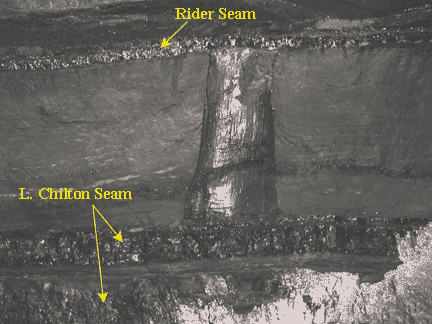
Sigillaria in an underground coal mine, Boone County, West Virginia.

Dimensions: ~34in. X ~10 in.
Although such finds are rather rare, occassionally Carboniferous-age fossil lycopods can be found in-situ or in their standing position as they originally grew-- and died-- encased in muddy sediments that later became rock.
Here, frozen in time, is the lower trunk of a Sigillaria tree sandwiched within a 34-in.-thick shale layer between the Lower Chilton Seam and a Rider Seam. This specimen was encountered during the normal course of underground mining operations and is clearly visible in this coal "pillar" which is an un-mined block left in order to help support the weight of the overlying mountain.
A close-up view. shows more details of this well-preserved fossil cast.
Coal swamp conditions during deposition of the Lower Chilton Seam were quiet for several thousand years, allowing enough peat to accumulate to yield a coal seam that even after compaction and de-volitalization (squeezing and cooking out of gas and water) has a net thickness of approximately 42 inches. A rapid and catastrophic flood event, however, deposited the entombing layer of shale in a matter of hours or days-- fast enough that before oxidation and decay set in the base of the Sigillaria tree was completely buried and sealed off from the atmosphere. Quiet conditions returned and coal depostion briefly resumed, laying down the 4-5 inch thick coal Rider Seam that lies above.
Overhead in the mine roof itself were these delicate details of circular leaf scars within a fluted bark pattern from other Sigillaria specimens that grew and died later. In life, a leaflet was attached at the small dimple-like structure within each scar.
The trip to get to this fossil required a 3 mile ride underground through existing mine entries that involved a combination of battery locomotive and battery personnel carrier as the mode of transportation. The vertical depth at the location where this fossil resides is approximately 700 feet.
Rock Type: Gray shale
Formation: Kanawha
Interval: Lower Chilton seam
Age: Middle Pennsylvanian Period, approx. 308 million years.
Location: Boone County, West Virginia; Candice Mine No. 2, operated by Peabody Coal Company, located about 2.4 miles west of Wharton, West Virginia. Collecting by the public is generally not available here.